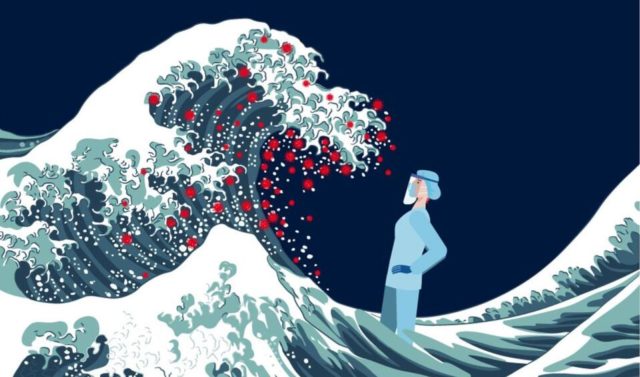Data shows that while the Northern Cape never technically exited the second wave it has had a steady increase in Covid-19 cases
EXPERTS are convinced that the rest of the country will inevitably follow suit after three provinces confirmed they entered their third wave of Covid-19 this week.
Professor Adrian Puren, acting executive director of the National Institute for Communicable Diseases (NCID), confirmed the country had not yet met the criterion for a national resurgence but the Free State had entered its third wave.
Additionally, both Gauteng Premier David Makhura and Eastern Cape Premier Oscar Mabuyane said on Friday that their provinces were batting the third wave.
According to data from the national Department of Health and the NICD, KwaZulu-Natal, Mpumalanga, the North West and the Western Cape have experienced sustained increases over the last couple of weeks.
The information also showed that while the Northern Cape never technically exited the second wave it has had a steady increase in cases.
There were 10,669 new infections nationally between this Monday to Friday and 7,665 cases during Monday and Friday for the prior week.
As the national third wave loomed, Health Minister Zweli Mkhize said meetings were being held with the National Coronavirus Command Council and the Ministerial Advisory Committee (MAC) on how best to hold off the national resurgence.
But Mkhize conceded the country would have to enforce additional restrictions to combat rising infections.
“The reality is that as numbers rise, we have to increase restrictions and when they go down, we ease them. We are going to recommend more focus on the size of gatherings,” said Mkhize.
Infectious diseases epidemiologist Professor Salim Abdool Karim, former chair of the Covid-19 MAC, said the third wave would hit in winter between June and July.
“Complacency is the enemy. When we let our guards down and think we’re safe, we get hit the hardest,” he said.
Last weekend, it was learnt the country not only had to contend with the 501Y.V2 variant that caused the second wave but also the B1.617 devastating India and the B1.1.7 variant dominant in the UK.
However, Abdool Karim said he was not concerned about the new arrivals.
“There are similarities between them and the 501Y.V2 and the country made it through the second wave. I don’t think these new variants will cause the third wave,” said Abdool Karim.
He said his greatest fear was a new variant born and bred in the country that bypassed immunity the population gained during previous waves.
“The 501Y.V2 was found in our country, what if it happens again? If a new variant emerges with the ability to avoid immunity as the result of efforts we’ve made to mitigate previous variants then we could see reinfections.”
Infectious diseases specialist Richard Lessells, group leader of the Kwazulu-Natal Research Innovation and Sequencing Platform that discovered the 501Y.V2 variant, said preventative measures remained the same.
“Regardless of variants, the main determining factors are our behaviour, the quality of the public health response, and viral evolution. The virus needs us to travel and evolve. Fundamental public health responses and our prevention measures like mask-wearing and social distancing remain vital.”
Lessells said, based on current understanding, people infected during the second wave had natural immunity from the 501Y.V2 and were likely protected against infection from other variants like the B.1.617 and B.1.1.7.
Hopes to end the pandemic, in the long run, are tied to vaccinations, but it was believed to not likely prevent the third wave.
Professor Mosa Moshabela, health committee chairperson of the Academy of Science of SA, said to achieve current goals, the country would need to vaccinate between 250,000 to 300,000 people per day.
“The roll-out programme is unfolding at a painfully slow pace, regardless of all the reasons we receive for the delays. We have done enough in securing vaccine doses, but not enough in preparing the country to receive vaccines and vaccinate people.”
The national Department of Health set the vaccination target at about 40.4 million people to cross the 67% threshold needed for herd immunity and estimated it to be achieved in February 2022.
Currently, the only vaccinations being done are part of the Sisonke Study for the Johnson & Johnson vaccine.
At the start of the weekend, just under 500,000 health care workers had been vaccinated as part of the study.
But the study was hindered by a momentary hurdle when it was suspended by SA Health Products Regulatory Authority on April 13 to investigate rare and severe blood clots detected in six vaccinated Americans.
The study resumed on April 28, but it ends this weekend and would not be expanded to the general public as Phase 2 of the national roll-out was expected to begin on Monday.
The Health Department was expected to vaccinate the remaining 500,000 to 700,000 health care workers in the country.
Monday’s roll-out is for those over the age of 60, and from July people over 40 would be added to Phase 2, as well as those in old age homes and prisons, according to the Health Department.
The department would then begin Phase 3 of the roll-out in November to vaccinate everyone over the age of 18 – an estimated 22.6 million people.
The Pfizer-BioNTech and J&J vaccines will be used for the roll-out.








